

Back in the early 70's, stereo receivers such as the Marantz 2235 were the audio components many budding audiophiles wanted to buy. Why? They were built like tanks and sounded better than most other components in its day.
In the late 70's and early 80's my family owned a stereo store in Skokie, IL and we sold (among other brands) Marantz components. I was always impressed by those old receivers, but little did I know that in subsequent years, Marantz would undergo great changes and those great monster receivers would go the route of becoming "mediocre" stereo equipment.
I always wished I had kept one of those old receivers just to remember the days when I worked in our family's store. Now years later, while checking out the offerings of eBay, I found that some companies have been restoring these great stereo components and selling them again! Well, I snatched up three different models of Marantz receivers as quick as I could, and I hope to get one or two more in the future. This one above just arrived today, so I waited to post this just so I could take a photo of it to show it off.
But as I was preparing to take the photo, I thought this might also serve as a lesson on photography as well.
If you look at the first photo only, you might say, "Wow... nice shot." But if you look at the second photo, you can clearly see there's a lot more to that old Marantz 2235 than you thought! Yes, you can see the nice glow of those gorgeous blue lights that helped define the look of those classic Marantz receivers! And in case you are wondering, the light are ON in the first photo... you just can't tell.
How did I get the lights to show in that second shot ?
Well, it's actually a "time exposure" shot along with a flash! It's called, "Dragging The Shutter," and it's a technique I often use in wedding photography when shooting the formal group photos!
You see, the first shot is just a typical flash shot. It exposes the image properly for the majority of the receiver, but it does nothing for the glowing blue lights. So, by leaving the shutter of the camera open longer and mounting the camera on a tripod, the flash exposes the whole receiver but the long exposure allows the lights from the tuning dial to record on the image sensor of my digital camera as well. In wedding photography, this technique allows me to get those nicely lit photos of my clients as well as getting nicely lit backgrounds of the church!
For the technically-minded reader, the first shot was taken at 1/60 second at f 8.0 with a flash. The second shot was taken at 1 second at f 8.0 with a flash. The second shot is properly exposed by the flash with an aperture of f 8.0, but because the shutter remains open for a full second (much longer than 1/60 second) it allows the light from the receiver's tuning dial to record as well.
Cool, huh?
:)
For more information on old Marantz receivers, check out this site: http://www.classic-audio.com/marantz/mindex.html











